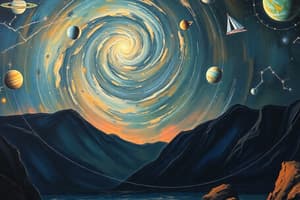Podcast
Questions and Answers
What is the Latin name for the constellation that represents the 'Queen of Ethiopia'?
What is the Latin name for the constellation that represents the 'Queen of Ethiopia'?
- Andromeda
- Cepheus
- Aquarius
- Cassiopeia (correct)
What is the Latin name for the constellation that represents the 'Twins'?
What is the Latin name for the constellation that represents the 'Twins'?
- Cetus
- Gemini (correct)
- Aquarius
- Apus
What is the main reason for the stars not being visible in the day time?
What is the main reason for the stars not being visible in the day time?
- The stars are actually very faint and are only visible at night because there is no light from the Sun
- The Earth's atmosphere scatters sunlight, making it difficult to see the stars during the day (correct)
- The stars are not actually in the sky during the daytime
- The Earth's rotation blocks the stars from being seen
Which of the constellation names represents a 'Sea monster (whale)'?
Which of the constellation names represents a 'Sea monster (whale)'?
What is the name of the constellation that represents a 'Bird of Paradise'?
What is the name of the constellation that represents a 'Bird of Paradise'?
What is the English name for the constellation with the Latin name 'Aquarius'?
What is the English name for the constellation with the Latin name 'Aquarius'?
What should you do to make the dots of light visible on the wall in the described experiment?
What should you do to make the dots of light visible on the wall in the described experiment?
Which of the following planets is NOT an inner planet?
Which of the following planets is NOT an inner planet?
How many constellations are there in total?
How many constellations are there in total?
What is the approximate thickness of the Earth's mantle?
What is the approximate thickness of the Earth's mantle?
What is the main difference between inner and outer planets?
What is the main difference between inner and outer planets?
What is the name given to the inner planets because of their solid and rocky surfaces?
What is the name given to the inner planets because of their solid and rocky surfaces?
What are the two primary elements that compose the oceanic crust, giving it the nickname 'SIMA'?
What are the two primary elements that compose the oceanic crust, giving it the nickname 'SIMA'?
Which of these statements about the Earth's core is incorrect?
Which of these statements about the Earth's core is incorrect?
Where is the main asteroid belt located in our solar system?
Where is the main asteroid belt located in our solar system?
What is the primary reason the inner core is solid even though it's extremely hot?
What is the primary reason the inner core is solid even though it's extremely hot?
What is a meteoroid?
What is a meteoroid?
Which of the following layers of the Earth is not composed primarily of Silicon and Magnesium?
Which of the following layers of the Earth is not composed primarily of Silicon and Magnesium?
What happens when a meteoroid enters Earth's atmosphere?
What happens when a meteoroid enters Earth's atmosphere?
What is the difference between a meteor and a meteorite?
What is the difference between a meteor and a meteorite?
What is the nickname given to the Earth's core because of its primary constituents?
What is the nickname given to the Earth's core because of its primary constituents?
Why are outer planets called gas giants?
Why are outer planets called gas giants?
What percentage of the Earth's volume is occupied by the mantle?
What percentage of the Earth's volume is occupied by the mantle?
Which layer of the Earth is responsible for the Earth's magnetic field?
Which layer of the Earth is responsible for the Earth's magnetic field?
What is the estimated age of the Earth?
What is the estimated age of the Earth?
What is the shape of the Earth?
What is the shape of the Earth?
Which of these is NOT an effect of the Earth's rotation?
Which of these is NOT an effect of the Earth's rotation?
What are the four main components or subsystems of the Earth?
What are the four main components or subsystems of the Earth?
What are the three main components of the Earth's internal structure?
What are the three main components of the Earth's internal structure?
What type of rocks are formed from the cooling and solidification of magma or lava?
What type of rocks are formed from the cooling and solidification of magma or lava?
How can we obtain knowledge about the Earth's internal structure?
How can we obtain knowledge about the Earth's internal structure?
What is the primary difference between sedimentary rocks, igneous rocks, and metamorphic rocks?
What is the primary difference between sedimentary rocks, igneous rocks, and metamorphic rocks?
What does the term 'pre-history' refer to in the context of archeology?
What does the term 'pre-history' refer to in the context of archeology?
What are fossils used for in archeological studies?
What are fossils used for in archeological studies?
Which of these is not a sub-species within the genus 'Homo'?
Which of these is not a sub-species within the genus 'Homo'?
What is the significance of archeological sites in the study of human evolution?
What is the significance of archeological sites in the study of human evolution?
What is the primary purpose of archeology in understanding human evolution?
What is the primary purpose of archeology in understanding human evolution?
What is the meaning of the term 'bi-pedal' in relation to human evolution?
What is the meaning of the term 'bi-pedal' in relation to human evolution?
What is the key characteristic that distinguishes 'Homo habilis' from other early hominids?
What is the key characteristic that distinguishes 'Homo habilis' from other early hominids?
What is the approximate percentage growth rate of Ethiopia's population from 1960 to 2007?
What is the approximate percentage growth rate of Ethiopia's population from 1960 to 2007?
During which decade did Ethiopia experience the highest population growth rate based on the provided data?
During which decade did Ethiopia experience the highest population growth rate based on the provided data?
What does the text define as the most common and simple measure of fertility?
What does the text define as the most common and simple measure of fertility?
Which of the following is NOT considered a major component of population dynamics?
Which of the following is NOT considered a major component of population dynamics?
What is the main reason for the growth of world population, according to the content?
What is the main reason for the growth of world population, according to the content?
What is the primary way a society replenishes itself?
What is the primary way a society replenishes itself?
Which of the following is a biological factor affecting population dynamics?
Which of the following is a biological factor affecting population dynamics?
What is the primary difference between fertility and birth rate?
What is the primary difference between fertility and birth rate?
Flashcards
Constellations
Constellations
Patterns formed by groups of stars in the night sky.
Total Constellations
Total Constellations
There are 88 constellations that cover the night sky.
Andromeda
Andromeda
A constellation known as Princess of Ethiopia.
Cassiopeia
Cassiopeia
Signup and view all the flashcards
Cepheus
Cepheus
Signup and view all the flashcards
Aquarius
Aquarius
Signup and view all the flashcards
Cetus
Cetus
Signup and view all the flashcards
Star Visibility
Star Visibility
Signup and view all the flashcards
Orbits
Orbits
Signup and view all the flashcards
Inner planets
Inner planets
Signup and view all the flashcards
Outer planets
Outer planets
Signup and view all the flashcards
Asteroids
Asteroids
Signup and view all the flashcards
Asteroid belt
Asteroid belt
Signup and view all the flashcards
Meteoroids
Meteoroids
Signup and view all the flashcards
Meteors
Meteors
Signup and view all the flashcards
Meteorites
Meteorites
Signup and view all the flashcards
Sedimentary Rocks
Sedimentary Rocks
Signup and view all the flashcards
Earth's Age
Earth's Age
Signup and view all the flashcards
Oblate Spheroid
Oblate Spheroid
Signup and view all the flashcards
Rotation of the Earth
Rotation of the Earth
Signup and view all the flashcards
Revolution of the Earth
Revolution of the Earth
Signup and view all the flashcards
Lithosphere
Lithosphere
Signup and view all the flashcards
Hydrosphere
Hydrosphere
Signup and view all the flashcards
Rock Classification
Rock Classification
Signup and view all the flashcards
Oceanic Crust
Oceanic Crust
Signup and view all the flashcards
Mantle
Mantle
Signup and view all the flashcards
Core
Core
Signup and view all the flashcards
Inner Core
Inner Core
Signup and view all the flashcards
Outer Core
Outer Core
Signup and view all the flashcards
SIMA
SIMA
Signup and view all the flashcards
NIFE
NIFE
Signup and view all the flashcards
Earth's Layers
Earth's Layers
Signup and view all the flashcards
Human Evolution
Human Evolution
Signup and view all the flashcards
Archeology
Archeology
Signup and view all the flashcards
Fossils
Fossils
Signup and view all the flashcards
Homo
Homo
Signup and view all the flashcards
Homo erectus
Homo erectus
Signup and view all the flashcards
Homo sapiens
Homo sapiens
Signup and view all the flashcards
Pre-history
Pre-history
Signup and view all the flashcards
Bi-pedal
Bi-pedal
Signup and view all the flashcards
Population Growth Rate
Population Growth Rate
Signup and view all the flashcards
Fertility
Fertility
Signup and view all the flashcards
Mortality
Mortality
Signup and view all the flashcards
Migration
Migration
Signup and view all the flashcards
Birth Rate (BR)
Birth Rate (BR)
Signup and view all the flashcards
Population Dynamics
Population Dynamics
Signup and view all the flashcards
Ethiopia's Population Growth (1900-2007)
Ethiopia's Population Growth (1900-2007)
Signup and view all the flashcards
Components of Population Dynamics
Components of Population Dynamics
Signup and view all the flashcards
Study Notes
Grade 7 Social Studies Textbook (Ethiopia)
-
This textbook is a property of the school. Students must take good care of it.
-
Here are some tips to maintain the book:
- Cover the book with protective materials, such as plastic, old newspapers or magazines.
- Keep the book in a clean, dry place.
- Keep hands clean when handling the book.
- Do not write on the cover or inside pages.
- Use a bookmark, such as paper or cardboard, instead of writing on the pages.
- Do not tear or cut out pictures or pages.
- Repair any torn pages with paste or tape
- Pack the book carefully when putting it in a school bag.
- Handle the book with care when passing it to someone else, and lay the book flat when reading it.
-
The authors of the textbook are: Abebe Yibeltie Yayehyirad (MA), Dessalew Awaye Derese (BA), Mulugeta Dires Fetene (MA), and Tegegn Degelo Someno (MA).
-
The editors, reviewers, and evaluators of the textbook are: Solomon Wondimu Metaferia (MA), Belay Belete Birhanu (MA), and Getachew Talema Atinafu.
-
The textbook was developed and published in 2022 in Addis Ababa, Ethiopia.
-
The textbook covers a variety of topics in Social Studies for Grade 7, including:
- Physical characteristics of the Earth
- Human evolution and world population
- Human and natural resources
- Ancient civilizations and medieval history of the world
- Ancient history of Africa
- Contemporary global issues.
Studying That Suits You
Use AI to generate personalized quizzes and flashcards to suit your learning preferences.




